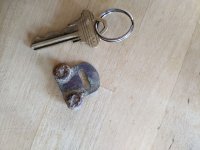As an owner of a couple of metal detectors, I have been interested in the hobby for a number of years. Also, as an electrical engineer, I have done some experimentation with most of my equipment. One aspect of the whole discussion concerning metal detecting is the lack of definitive information concerning the electrical characteristics of different units. We have all heard comments like: “Oh, I can detect a dime at ten feet.” Of course, I am exaggerating, but those are the kind of meaningless claims that one hears all the time.
Manufacturers are not required to publish air test and there are no standard targets for such tests. It is much like vacuum cleaners. If the industry was required to show vacuum in inches-of-water or mercury rather than amperes, one might be able to do real comparison shopping.
So much for the dissertation, I would like to propose a standardization test for owners of like metal detectors. If we could compile a set of statistics related to sensitivity of our units, then we could tell when something has degraded and our units are not working up to standard.
Since I own a Minelab X-terra 70, my comments will pertain to that unit. Here are some of my thoughts. Develop a set of Standardized test settings for Noise, Ground Balance, Sensitivity, and Threshold. Standardization of settings should be relatively easy, since the metal detector is computer controlled and all settings are digital (incremental), rather than analog. Whether to use “All Metal” or “Coin” mode is to be determined during this discussion. Use the standard coil that ships with the X-terra 70 (9” 7.5 kHz). Pay close attention to the test setup environment- outside on a wooden table, keeping a reasonable distance from all metal. Mount a wooden yard stick or other measuring device normal to the plane of the coil (perpendicular). Of course, the plane of the coil is positioned vertically. Using a “Standard” target, attempt to find the distance value where the Audio Threshold is broken or where a Depth indication is shown on the LCD, whichever is the most accurate and most repeatable. What the “Standard” target should be is also to be determined. Be as accurate as possible, not subjective or biased in your measurement.
Finally, record the findings and report back to this forum so that they may be included in a data base, which will yield an “average” value for sensitivity to the target. In this way, maybe we can develop a definitive standard for performance and be able to verify the overall operating health of our equipment.
I hope this posting will generate some constructive ideas and suggestions. Of course, it is possible that all this has been done in the forum. If so, then I would like to see the results of those tests. If not, then let’s do it. Old_tex
Old_tex
Manufacturers are not required to publish air test and there are no standard targets for such tests. It is much like vacuum cleaners. If the industry was required to show vacuum in inches-of-water or mercury rather than amperes, one might be able to do real comparison shopping.
So much for the dissertation, I would like to propose a standardization test for owners of like metal detectors. If we could compile a set of statistics related to sensitivity of our units, then we could tell when something has degraded and our units are not working up to standard.
Since I own a Minelab X-terra 70, my comments will pertain to that unit. Here are some of my thoughts. Develop a set of Standardized test settings for Noise, Ground Balance, Sensitivity, and Threshold. Standardization of settings should be relatively easy, since the metal detector is computer controlled and all settings are digital (incremental), rather than analog. Whether to use “All Metal” or “Coin” mode is to be determined during this discussion. Use the standard coil that ships with the X-terra 70 (9” 7.5 kHz). Pay close attention to the test setup environment- outside on a wooden table, keeping a reasonable distance from all metal. Mount a wooden yard stick or other measuring device normal to the plane of the coil (perpendicular). Of course, the plane of the coil is positioned vertically. Using a “Standard” target, attempt to find the distance value where the Audio Threshold is broken or where a Depth indication is shown on the LCD, whichever is the most accurate and most repeatable. What the “Standard” target should be is also to be determined. Be as accurate as possible, not subjective or biased in your measurement.
Finally, record the findings and report back to this forum so that they may be included in a data base, which will yield an “average” value for sensitivity to the target. In this way, maybe we can develop a definitive standard for performance and be able to verify the overall operating health of our equipment.
I hope this posting will generate some constructive ideas and suggestions. Of course, it is possible that all this has been done in the forum. If so, then I would like to see the results of those tests. If not, then let’s do it.




